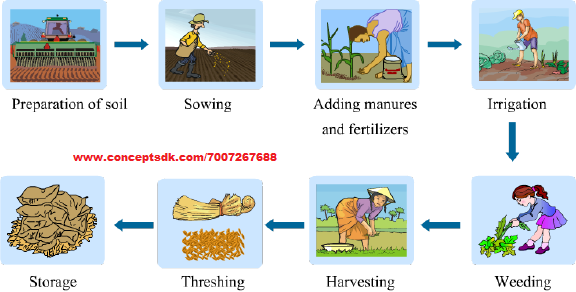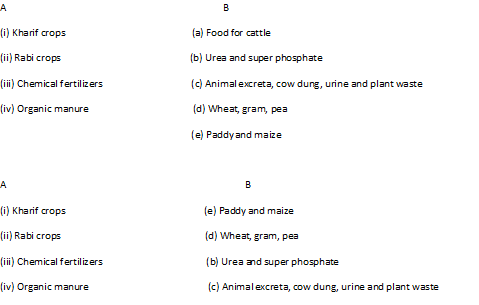
In order to provide food to our growing population, we need to adopt certain agricultural practices.
Same kind of plants grown and cultivated at a place constitute a crop.
In India, crops can be broadly categorised into two types based on seasons – rabi and Kharif crops.
It is necessary to prepare soil by tilling and levelling. Ploughs and levellers are used for this purpose.
Sowing of seeds at appropriate depths and distances gives good yield. Good variety of seeds are sown after selection of healthy seeds. Sowing is done by seed drills.
Soil needs replenishment and enrichment through the use of organic manure and fertilisers. Use of chemical fertilisers has increased tremendously with the introduction of new crop varieties.
Preparation of Soil:
(i) Few inches of the top sooil is loosened and turned ploughing/tilling.
(ii) Weeds are removed from the soil before removed from the soil before sowing the seeds.
(iii) Ploughed field has big soil pieces (crumbs) which are broken by planks.
(iv) Field is levelled for sowing.
Supply of water to crops at appropriate intervals is called irrigation.
Weeding involves removal of unwanted and uncultivated plants called weeds.
Harvesting is the cutting of the mature crop manually or by machines.
Separation of the grains from the chaff is called threshing.
Proper storage of grains is necessary to protect them from pests and microorganisms.
Food is also obtained from animals for which animals are reared. This is called animal husbandry.
Fertiliser: The inorganic compounds containing nutrients such as nitrogen, potassium and phosphorus. They are made in the factories. Example: Urea, ammonium sulphate, potash, etc.
Cultivator: Used for ploughing the soil and is driven by a tractor. This helps to save time and labour.
Hoe: Used for loosening the soil and for removing weeds.
Irrigation: Supplying of water to the crop plants from the wells, canals or water reservoirs.
Method of Irrigation:
(i) Tradition methods of Irrigation: Moat, Chain pump, Dheki, Rahat.
(ii) Modern methods of Irrigation: Sprinkler system, Drip system.
Harvesting: The cutting and collecting of the matured crops from the fields. Harvesting in our country is either done manually by sickle or by a machine called harvester.
Storage: Harvested food grains normally contain more moisture than required for storage. Large scale of storage of grains is done in silos and granaries to protect them from pest like rats and insects. Farmers store grains in jute bags or metallic bins.
Manure: A natural substance prepared from decomposition of plant and animal wastes (cow dung, animal bones, dead leaves, dead insects and vegetable wastes) by the action of microbes.
NCERT Solutions
Exercise : Solutions of Questions on Page Number : 13
Q1 : Select the correct word from the following list and fill in the blanks.
float, water, crop, nutrients, preparation
(a) The same kind of plants grown and cultivated on a large scale at a place is called _________.
(b) The first step before growing crops is ________ of the soil.
(c) Damaged seeds would _________ on top of water.
(d) For growing a crop, sufficient sunlight and _________ and _________ from the soil are essential.
Answer :
(a) The same kind of plants grown and cultivated on a large scale at a place is called _ crop _.
(b) The first step before growing crops is _preparation__ of the soil.
(c) Damaged seeds would __float__ on top of water.
(d) For growing a crop, sufficient sunlight and _ water __ and _ nutrients_ from the soil are essential.
Match items in column A with those in column B.

Q3 : Give two examples of each.
(a) Kharif crop
(b) Rabi crop
Answer : (a) Kharif crop → Paddy, maize
(b) Rabi crop → Wheat, gram
Q4 : Write a paragraph in your own words on each of the following.
(a) Preparation of soil (b) Sowing
(c) Weeding (d) Threshing
Answer : (a) Preparation of soil:
It is the first method to be followed before growing a crop. This method is usually employed for loosening the soil to allow the root to penetrate deep into it. The loosening of the soil helps in the growth of several soil microbes, earthworms etc., which enrich the soil with humus and other essential nutrients. Plants require nutrients for their proper growth and functioning. The process of loosening is called tilling or ploughing the soil. Tilling of soil brings the nutrient-rich soil to the top. This helps the plants to utilize the nutrients for their growth.
(b)Sowing: Sowing is another important step in crop production. It is the process of placing the seed in or on the soil for future growth. The seeds that are selected for growing should be of good quality. This will improve the net yield of the crop. Sowing is usually done with the help of either a traditional tool or a seed drill. The traditional tool is shaped like a funnel. It was used earlier for sowing seeds.
Nowadays, seed drills that make the use of tractors are used for sowing seeds. This tool disperses seeds uniformly and sows seeds
at proper depth. Sowing by this method saves time and also protects the seeds from birds.
(c)Weeding: Undesirable plants that grow along with the crop are known as weeds. Weeding is the process of removing these weeds.Xanthium, Parthenium, etc. are some common weeds. Weeds compete with the crop for nutrients, light, and space. As a result, crop plants get lesser nutrients, light, and space for their development. This in turn, reduces their productivity. Thus, various weeding methods are employed.
Some important weeding methods are:
(i) Weeds can be controlled using weedicides. It is a chemical, which is sprayed in the fields to kill all available weeds. Weedicides are not harmful to crops.
(ii) Tilling before sowing of crops also helps in removing weeds. Tilling uproots the weeds. The best time for removal of weeds is before they produce flowers and seeds.
(iii) The manual method of removing weeds is with the help of a khurpi. It involves regular uprooting or cutting of weeds close to the ground.
(d)Threshing: Threshing is the process of separating grains or seeds from chaff. It is done after harvesting the crop. It is usually carried out with the help of a machine known as ‘Combine’. This machine is a combined harvester and thresher. It harvests plants as well as cleans grains.
Q6 : What is irrigation? Describe two methods of irrigation which conserve water.
Answer : Irrigation is the process by which water is supplied to crops at different intervals. The time and frequency of irrigation varies according to different seasons, crops, and soil types. There are various sources of irrigation such as wells, canals, rivers, dams, ponds, and lakes. Two methods of irrigation which help in conservation of water are:
a) Sprinkler system: This system is more useful on uneven land, having fewer water supplies. In this method, water is supplied using pipes to one or more central locations within the field. When water is allowed to flow under high pressure with the help of a pump, it gets sprinkled on the crops.
b) Drip system: In this system, water is delivered at or near the roots of plants, drop by drop. This is the most efficient method of irrigation as there is no wastage of water at all. This method is important in areas where water availability is poor.
Q7 : If wheat is sown in the kharif season, what would happen? Discuss.
Answer : If wheat is sown in the kharif season (from June to October), then the whole crop might get destroyed because of many factors such as lack of optimum temperature, adaptability, availability of pests, etc. Kharif season includes the rainy season, which is not favourable for the growth of wheat crop. Therefore, wheat crop should not be sown during this season.
Q8 : Explain how soil gets affected by the continuous plantation of crops in a field.
Answer : Continuous plantation of crops in a field makes the soil poor in certain nutrients such as nitrogen, phosphorus, potassium, etc. Plants require nutrients for their proper growth and functioning. When a farmer continues to grow crops one after the other, then all nutrients available in the soil reduce and the crop yield decreases automatically.
Q9 : What are weeds? How can we control them?
Answer : Undesirable plants that grow along with crop plants are known as weeds. Xanthium, Parthenium, etc. are some common weeds.
Weeds compete with the crop for nutrients, light, and space. As a result, crop plants get lesser nutrients, light, and space for their development. This in turn, reduces their productivity. Thus, various weeding methods are employed. Some important weeding methods are:
i. Weeds can be controlled using weedicides. It is a chemical, which is sprayed in the fields to kill all available weeds. Weedicides are not harmful to crops.
ii. Tilling before sowing of crops also helps in removing weeds. Tilling uproots the weeds. The best time for the removal of weeds is before they produce flowers and seeds.
iii. The manual method of removing weeds is with the help of a khurpi. It involves regular uprooting or cutting of weeds close to the ground.

